Advertisement
A search for nautical "roots" turns up a bigger question: What makes us cherish the boats that we love?

John and Joan West, with their daughters Deborah and Stephanie aboard Jim West's 1973, 26-foot Lyman Sleeper.
For the past couple of years of used-boat shopping, my wife Stephanie and I have searched and circled back to certain boats, searched and circled back again, wading through options and styles that are at times vast and confusing. We've made many lists about what we must have, what we'd like, and what we each could and couldn't live without. There were deal-breaker features that we've both agreed upon, and through it all we slowly winnowed down our choices.
We decided that our next boat needed at least two berths, one for us and one for the new baby we were hoping to add to the crew, plus a transom door and swim platform for our dog Finn, who's very much part of the crew already. The boat had to be seaworthy enough to get us across the Chesapeake with no worries, have enough shade to keep us out of the sun, and faster than our present boat, to make day trips more practical. We were in sync on all these things, until Stephanie saw an Albin 28.
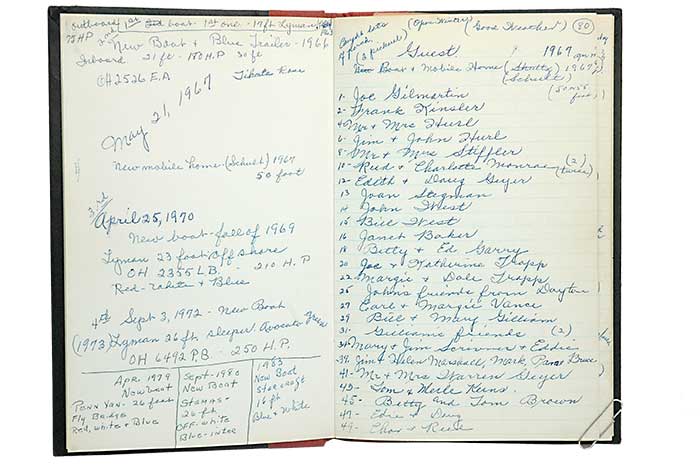
The first pages of Ruby's journal, filled with 25 years of adventures on Lake Erie.
"But, Steph, it barely cruises faster than our Marinette," I said, on alert that one of my most beloved features was on the table.
"I know," she said. "But I love this boat — the pilothouse, the look. It feels right. It feels like us."
We went around and around on this as, over time, her feelings for the Albin grew stronger until eventually she won me over as well. Mercifully, we now at least know the kind of boat we'd like to buy, and we can picture our lives in it. Meanwhile, we continued to enjoy another season on our present boat, hoping it would sell, and Stephanie and I received the happy news that we were expecting our first child. And then we got sad news; Stephanie's grandmother Ruby had passed away.
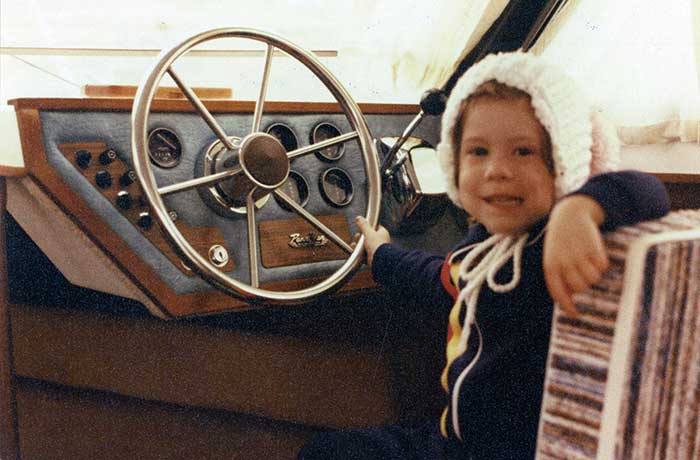
Stephanie, age 4, at the wheel of her grandfathers 26-foot Penn Yan.
A Legacy Of Boating
Ruby was a central figure in Stephanie's life since she was very young. After her father died when she was nearly 3, she lived with Ruby and her grandfather Jim. Her grandparents not only helped raise her and her older sister, but they also ran the daycare where she'd spend(t) her time during the week. On the weekends, Stephanie remembered Ruby and Jim packing up the whole family and heading to Lake Erie, to the trailer that was their home away from home on Catawba Island overlooking Herl's Harbor Marina, near Port Clinton, Ohio. There, they fished and played aboard a series of boats that Jim loved.
"They were there constantly on weekends," says Stephanie's aunt Edie. "It was easy and fun. We'd go up as young couples, go fishing, waterskiing, or just head over to the winery on the island. When we started having kids of our own, we'd bring our children up with us. We'd catch pounds of walleye and perch and cook them up for dinner."

Ruby on her namesake with her daughter Edie standing at the stern.
Ruby kept a journal of those idyllic, hectic days, recording each visitor, little anecdotes about the kids, what everyone did, where they took the boat, what they caught, how they cooked their meals, and so on — for 25 years. Through her detailed recordkeeping, you can watch their sons' girlfriends become wives, and read about each new grandchild's first visit to the lake.
Jim and Ruby's boats at that time were Lymans, built in nearby Sandusky. Jim liked to buy a new one roughly every three years, keeping them meticulously clean and maintaining them himself. When he walked over to the marina to open up the boat for a fishing trip, the whole family — kids, grandkids, everybody — knew they'd better give him 30 minutes of peace and quiet, to get everything just right, before they could all descend upon him. Help was not required, or desired.
"He liked the Lymans because the hull was deeper, they had more freeboard, and he didn't have to worry about the grandkids falling out," says Edie. "They have such a nice clean look. If I was to go out and buy a boat right now, I'd buy a Lyman."
The passion for boating is passed down from generation to generation as a shared experience, occasionally skipping one generation only to be picked up by the next, thanks to grandparents. But can early-childhood experiences alter your preferences in boats at the same time? Being so young at the time, Stephanie doesn't have clear memories of her grandfather's boats on Lake Erie, but she does remember the endless card games with her cousins, the family fishing excursions with Grandpa, the sound of the rain against the trailer's metal roof.
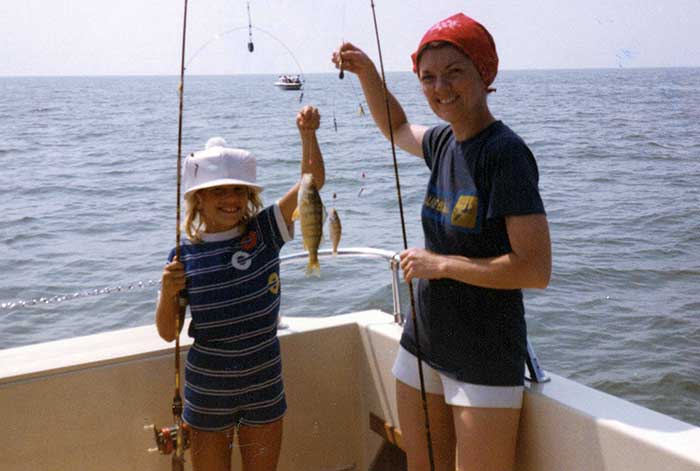
Edie and her daughter Molly, with some nice perch.
Eventually, after her mother remarried, and moved her two girls to Islamorada, Florida, she kept up her family's boating traditions. "Some of my strongest memories are of growing up with skiffs and center consoles in Florida," Steph has told me. So, I would've thought her boat preferences would follow suit. But no. Modern express cruisers hold zero appeal, despite their considerable popularity. When we were hunting for a boat nine years ago, while we were still just dating, she helped steer me away from a very nice Sea Ray and toward an older, but considerably more classic-looking Marinette.
The Marinette has since become a huge part of our relationship — first as our weekend getaway when we were dating; later as a test of our compatibility as DIY-engine-repair projects stretched for weeks; it was even our honeymoon vehicle of choice, on which we cruised the islands of the Chesapeake.
Putting The Pieces Together
It wasn't until we arrived at Ruby's wake in Springfield, Ohio, that the penny dropped. There, among the photos being passed around documenting her well-lived life, was a shot of Ruby standing at the transom of a 26-footer, one of the last boats Jim bought. Ruby, who'd reached 95 years of age when she passed away in 2010, was in her mid-60s in the photo — her hair held back in one of her favored scarves, smiling in the knee-deep water with a hand atop the transom, the look of pure contentment on her face.

Jim's second Lyman, a 1966, 21-footer, now owned by the Drossel family.
When we saw that photo, something clicked for Stephanie. There it all was — the engine box, the cutouts for the cleats, the wide-open cockpit for fishing, the classic lines. All of these could be found ... on an Albin. What she'd been searching for, especially as a new life was entering the stage as a beloved one was departing, was a vessel that could hold safely within it those precious family times, those feelings of security and love. She'd been looking for her grandfather's boat.
Lasting Love For The Legendary Lyman
Dan Bracken of Cleveland, Ohio, owns one of Stephanie's grandfather's old Lymans — the 1970, 23-foot Offshore Lyman that Jim West originally purchased four decades ago. Bracken has owned nine Lymans in his lifetime. The son of a home boatbuilder, he grew up listening to his father praise Lyman as a designer and a builder.
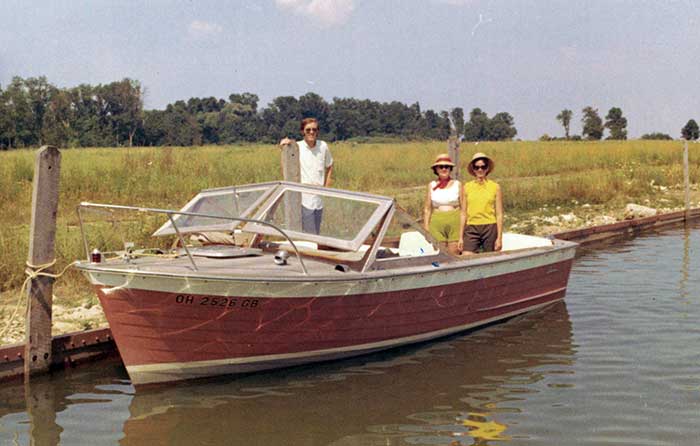
Jim's second Lyman, a 1966, in the summer of 1969, with John, Ruby, and Joan on Middle Bass Island.
Founded in 1875 by cabinetmakers Bernard and Herman Lyman, Lyman Boats was originally based in Cleveland, where they turned out high-quality, lapstrake rowboats and sailboats. Their 15-foot rowboat, with its tall, plumb bow and extended keel, could comfortably hold five passengers and was used by the City of Cleveland Lifeguards at the turn of the century.
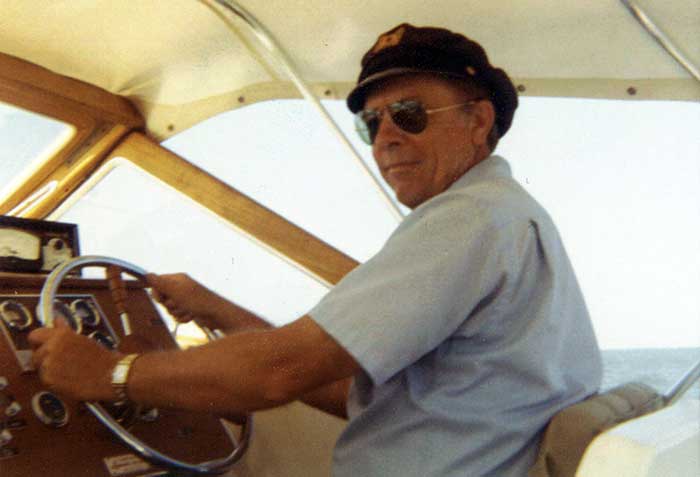
Jim West at the wheel of his third Lyman, a 23-Offshore, now owned by Dan Bracken.
Early Lymans had a nearly plumb bow, with a fine entry that helped slice through Lake Erie's legendary steep chop. They became the preferred boat in the region during the post-World War II boatbuilding explosion, turning out as many as 4,000 a year. "Lymans were designed for Lake Erie," says Bracken. "The clinker-built lapstrake-hull design traps a foil of air under each strake when the boats get on plane, improving performance." In the 60s, the bow angle took on a more raked-back profile and the availability of reliable and more powerful inboards from Chrysler and others further improved the performance. The Lyman family would produce wooden boats on the shores of Lake Erie for nearly a century, closing up shop for good in 1973. Lymans are still sought-after classics on the lake, with an owners' group 500 strong and several websites dedicated to their maintenance and restoration.
Bracken's eighth Lyman, a 25 Offshore, was named My Last One by the previous owner. "I liked that so much I didn't change it," he says, "But then I got another one."
